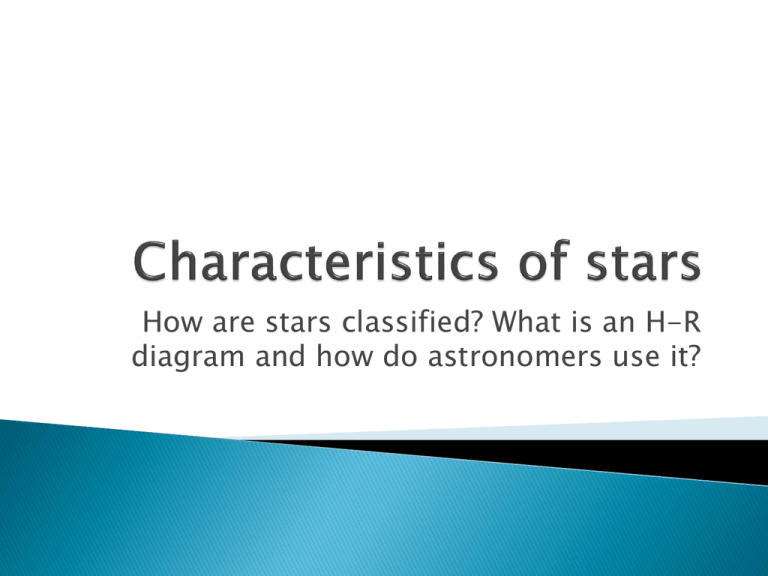Characteristics of stars
advertisement

How are stars classified? What is an H-R diagram and how do astronomers use it? What does a star’s color indicate? Surface temperature. What are some colors of stars? Yellow, blue - white or reddish What color are the hottest stars? Bluish(question on Winter’s interim test) A star’s color reveals its surface temperature. Red has a temperature of about 3200 Celsius. Yellow has a surface temperature of about 5500 Celsius. Hottest stars with a surface temperature of over 20,000 Celsius appear bluish. Why is it difficult to tell how large a star is? Stars appear to be small because they’re very far away. Really, some are much larger than our Sun. Astronomers use spectrographs to determine the elements found in stars. A spectrographs separates light into the individual colors of which it is made. Then it produces an image of the resulting spectrum. Most large telescopes have spectrographs to analyze light. How can the chemical elements be identified using spectrums? Each element has its own signature spectrum, just like each person has a unique set of fingerprints. When the star’s light is seen through a spectrograph, each absorbed wavelength is shown as a dark line on a spectrum. So what are the dark lines in a spectrum? Wavelengths of light absorbed by the element. what happens to some of the light as it passes through the gases in the outer layers of a star? The gases absorb certain wavelengths of light, leaving dark lines in the spectrum. Brightness of a star depends on its size and also its temperature. What are the two ways to describe a star’s brightness? Apparent brightness, and absolute brightness. Apparent brightness: how bright a star looks from Earth. Absolute brightness: how bright a star would look if it were at the standard distance from Earth. What information is needed to determine a star’s absolute brightness ?Apparent brightness and distance from Earth. Example: imagine that you are riding in a car at night, and two cars are approaching from the opposite direction. which car appears to have brighter headlights? The car that is closer. Does that mean the headlights are actually brighter? Not necessarily, the headlights on the other car may be the same brightness but appear dimmer because they are farther away. The brightness of the headlights was like apparent brightness of stars. The scientists made graphs to see if the temperature and the absolute brightness of stars were related. They recorded information for many stars and developed a diagram called an H-R diagram to classify stars and understand how they change over their lifetimes. Where do most stars fall on the H-R diagram? Most stars are main sequence stars. What kind of star is our sun? It is a main sequence star. Do all main sequence stars look like our sun? No, some can be blue or blue -white instead of yellow. Others are orange or red. What else do you need to know to classify a star as a main sequence star? It’s absolute brightness. Students page 114 figure 3 –comment on categories i.e. supergiant, color, temperature etc. and him. What one can observe of figure 3 that we just saw is that astronomers use HR diagrams to classify stars and to understand how stars change over time. Most of the stars in the diagram form a diagonal area called the main sequence. More than 90% of all stars, including the sun, are main sequence stars. Within the main sequence, the surface temperature increases as absolute brightness increases. Hot blue stars are located at the left of an HR diagram and cooler red stars are located at the right of the diagram. The brightest stars are located near the top of an H-R diagram while the dimmest stars are located at the bottom. Giant and supergiant stars are very bright. They can be found near the top center and right of the diagram. White dwarfs are hot but not very bright located at the bottom left or bottom center of the diagram. Homework: Explore and explain the creation of an H-R diagram. Draw a diagram and highlight in a chart the key points.






